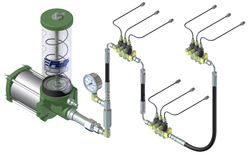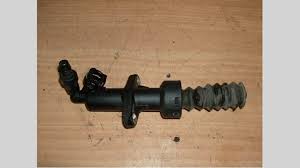Central lubrication systems are an essential component in improving the efficiency and longevity of equipment across various industries. With the rapid advancements in technology and automation, it has become crucial for businesses to optimize their operations by minimizing time-consuming maintenance tasks and reducing costly downtime. Central lubrication systems offer a practical solution by providing automated and precise lubrication to multiple points within complex machinery, ensuring optimal performance and extended service life. In this article, we will explore the benefits of central lubrication systems, their working principles, and how they can enhance equipment efficiency while simultaneously saving costs for businesses.
The Isohitech Central Lubrication System is a cutting-edge and reliable solution for efficient machinery lubrication. It utilizes advanced technology to ensure consistent and optimal lubrication, reducing friction and extending the life of critical components. This system streamlines maintenance processes, minimizing downtime and enhancing overall operational efficiency. With its customizable options, the Isohitech Central Lubrication System provides automated lubrication at regular intervals, promoting smooth machinery operation and reducing wear. It is a cost-effective and user-friendly choice, offering reliable lubrication for a wide range of industrial applications, ultimately improving productivity and equipment performance.
What are Central Lubrication Systems?
Central lubrication systems are a type of automatic lubrication system that aim to enhance the efficiency and lifespan of equipment. These systems are designed to deliver the right amount of lubricant to various components of machinery at regular intervals, ensuring smooth operation and reducing wear and tear. By automating the lubrication process, central lubrication systems eliminate the need for manual greasing, which can be time-consuming and prone to human error.
One key benefit of central lubrication systems is improved equipment performance. The consistent application of the correct amount of lubricant helps reduce friction between moving parts, minimizing heat generation and energy consumption. This ultimately leads to increased productivity as machines can operate at optimal levels without interruptions or breakdowns caused by insufficient or excessive lubrication.
In addition to improving efficiency, central lubrication systems also contribute to cost savings in terms of maintenance and repairs. Properly lubricated machinery experiences less wear on critical components such as bearings, gears, and seals, resulting in longer service life. This not only reduces replacement costs but also minimizes downtime associated with unscheduled repairs. Moreover, by eliminating manual greasing processes, labor costs are reduced as employees’ time can be allocated towards other tasks that add value to the organization’s operations.
Benefits of Central Lubrication Systems
Central lubrication systems offer several benefits that can enhance the efficiency of equipment in various industries. Firstly, these systems ensure a consistent and precise amount of lubrication is delivered to critical parts of the equipment at regular intervals. This eliminates the need for manual lubrication, reducing downtime and increasing productivity. Additionally, central lubrication systems help to extend the lifespan of equipment by minimizing wear and tear on moving parts. With proper lubrication, friction and heat generation are reduced, preventing premature breakdowns and costly repairs.
Furthermore, central lubrication systems contribute to improved safety in the workplace. By automating the lubrication process, workers are not required to manually handle or be exposed to potentially hazardous substances such as oils or greases. This minimizes the risk of accidents or injuries related to improper handling or spills. Moreover, with centralized control over the lubrication process, maintenance personnel can easily monitor and adjust settings as needed, ensuring optimal performance and preventing potential machinery malfunctions.
In conclusion, central lubrication systems provide significant benefits that contribute to enhanced equipment efficiency across various industries. These systems eliminate manual labor for lubing machines while delivering precise amounts of lubricant at regular intervals. By extending equipment lifespan through reduced wear and tear on moving parts, central lubing systems minimize downtime and costly repairs. Additionally, they improve workplace safety by automating the process and reducing exposure to hazardous substances while offering centralized control for effective monitoring and adjustments.
Factors to Consider when Implementing a Central Lubrication System
One important factor to consider when implementing a central lubrication system is the type of equipment being used. Different types of equipment may require different types of lubricants and application methods. It is important to select a central lubrication system that can accommodate the specific needs of the equipment in order to ensure optimal performance and longevity.
Another factor to consider is the size and layout of the equipment. Central lubrication systems typically involve a network of distribution lines that deliver lubricant to various points on the equipment. It is important to design and install these distribution lines in a way that allows for easy access and efficient delivery of lubricant. This may require careful planning and coordination with other components or systems within the equipment.
Finally, it is crucial to consider maintenance requirements when implementing a central lubrication system. Regular maintenance, including monitoring fluid levels, inspecting distribution lines, and replacing filters or fittings, will be necessary to ensure optimal performance and prevent breakdowns or malfunctions. Considering these factors before implementing a central lubrication system can help ensure its effectiveness in enhancing equipment efficiency.
Case Studies: Success Stories of Improved Equipment Efficiency
Case Study 1: A manufacturing company in the automotive industry was experiencing frequent breakdowns and high maintenance costs due to improper lubrication of their equipment. They decided to implement a central lubrication system to ensure that every part of the machinery was properly lubricated at all times. After the installation, they saw a significant decrease in breakdowns and maintenance costs. The centralized system allowed for consistent and precise application of lubricants, reducing friction and wear on moving parts. This resulted in improved equipment efficiency, as machines were able to run smoothly for longer periods without interruption.
Case Study 2: An agricultural farm was struggling with inefficient use of tractors and implements due to inconsistent lubrication practices. They opted for a central lubrication system that automatically delivered the right amount of grease or oil to each component as needed. With this new system in place, they observed fewer instances of equipment failure and reduced downtime for repairs. The centralized approach also allowed them to monitor and control lubrication levels more effectively, avoiding over- or under-lubrication issues. As a result, their equipment’s overall efficiency improved significantly, leading to increased productivity on the farm.
These case studies highlight how implementing central lubrication systems can lead to success stories of improved equipment efficiency across various industries.
Tips for Maintaining and Optimizing Central Lubrication Systems
One key tip for maintaining and optimizing central lubrication systems is to regularly inspect and clean the system. Over time, dirt, debris, and contaminants can accumulate in the lubrication system, which can lead to clogs or reduced efficiency. By regularly inspecting and cleaning the system, you can ensure that it is functioning properly and that the lubricant is able to flow smoothly through all components.
Another important tip is to use high-quality lubricants that are specifically designed for your equipment. Using the wrong type of oil or grease can cause friction and wear on the equipment, leading to premature failure. It is essential to consult with manufacturers or industry experts to determine the right lubricant for your specific application.
Additionally, implementing a regular maintenance schedule is crucial for optimizing central lubrication systems. This includes checking fluid levels, replacing filters when necessary, inspecting fittings and hoses for leaks or damage, and ensuring that all components are properly aligned. Regular maintenance helps prevent unexpected breakdowns and extends the lifespan of both the lubrication system and equipment it supports.


